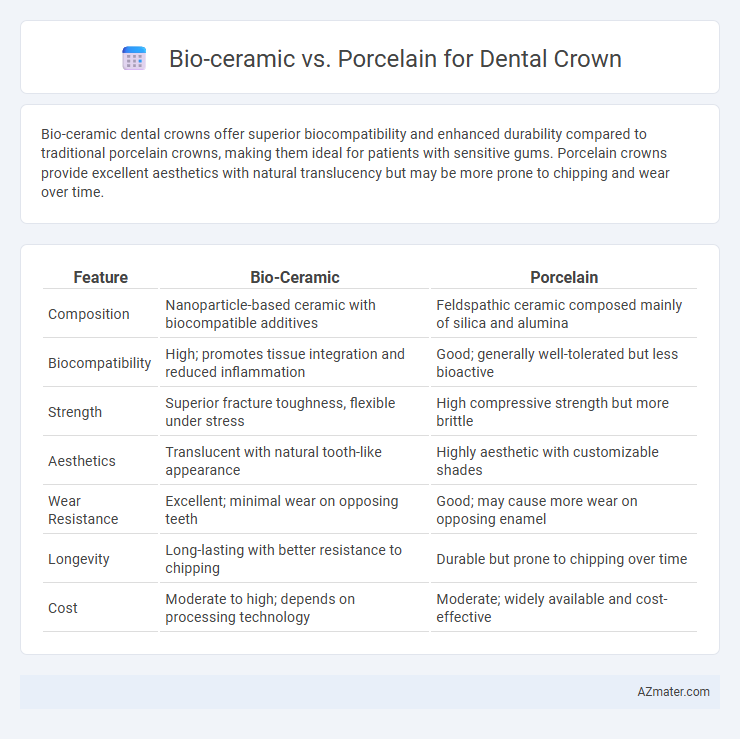Bio-ceramic dental crowns offer superior biocompatibility and enhanced durability compared to traditional porcelain crowns, making them ideal for patients with sensitive gums. Porcelain crowns provide excellent aesthetics with natural translucency but may be more prone to chipping and wear over time.
Table of Comparison
| Feature | Bio-Ceramic | Porcelain |
|---|---|---|
| Composition | Nanoparticle-based ceramic with biocompatible additives | Feldspathic ceramic composed mainly of silica and alumina |
| Biocompatibility | High; promotes tissue integration and reduced inflammation | Good; generally well-tolerated but less bioactive |
| Strength | Superior fracture toughness, flexible under stress | High compressive strength but more brittle |
| Aesthetics | Translucent with natural tooth-like appearance | Highly aesthetic with customizable shades |
| Wear Resistance | Excellent; minimal wear on opposing teeth | Good; may cause more wear on opposing enamel |
| Longevity | Long-lasting with better resistance to chipping | Durable but prone to chipping over time |
| Cost | Moderate to high; depends on processing technology | Moderate; widely available and cost-effective |
Introduction to Dental Crowns: Bio-ceramic vs Porcelain
Dental crowns are essential in restorative dentistry, designed to protect damaged teeth and restore their function and appearance. Bio-ceramic crowns are gaining popularity due to their biocompatibility, enhanced durability, and ability to integrate with natural tooth tissue. Porcelain crowns, known for their superior aesthetic qualities and translucency, remain a preferred choice for front teeth restorations.
Understanding Bio-ceramic Crowns: Composition and Benefits
Bio-ceramic crowns are composed of advanced zirconia and alumina materials that provide exceptional strength and biocompatibility, reducing the risk of allergic reactions and gum irritation. Their high translucency mimics natural tooth enamel, offering superior aesthetic results compared to traditional porcelain crowns. These crowns also exhibit enhanced wear resistance and durability, making them a preferred choice for long-term dental restorations.
Porcelain Crowns: Features and Aesthetic Appeal
Porcelain crowns offer exceptional aesthetic appeal due to their translucency and ability to closely mimic the natural color and texture of teeth, making them ideal for front teeth restorations. Their biocompatibility ensures minimal irritation to surrounding gum tissue, promoting long-term oral health. Advanced porcelain formulations also provide strong resistance to staining and wear, maintaining a natural and vibrant smile over time.
Strength and Durability Comparison: Bio-ceramic vs Porcelain
Bio-ceramic dental crowns exhibit higher fracture toughness and superior resistance to wear compared to traditional porcelain crowns, making them more durable under biting forces. Porcelain crowns, while aesthetically pleasing, are more prone to chipping and cracking due to their brittleness and lower tensile strength. Advances in bio-ceramic materials, such as zirconia-reinforced composites, provide enhanced longevity and improved performance in high-stress areas of the mouth.
Biocompatibility and Patient Safety Considerations
Bio-ceramic dental crowns exhibit superior biocompatibility due to their high inertness and minimal risk of allergic reactions, making them ideal for patients with metal sensitivities. Porcelain crowns, while aesthetically pleasing, may pose slight risks of gingival irritation or allergic response in sensitive individuals due to potential metal substructures or glazing materials. Patient safety considerations prioritize bio-ceramic options for reducing inflammation and promoting tissue integration, ensuring long-term oral health and reduced complications.
Aesthetics: Natural Look and Color Matching
Bio-ceramic dental crowns offer superior aesthetics with their ability to closely mimic the natural translucency and color variations of real teeth, making them ideal for front teeth restorations. Porcelain crowns also provide excellent color matching and a natural appearance but can sometimes appear more opaque compared to bio-ceramics. Both materials allow for custom shading and layering techniques, enhancing the overall natural look and seamless blending with adjacent teeth.
Longevity and Maintenance Requirements
Bio-ceramic dental crowns offer superior longevity due to their high resistance to wear and chipping, making them ideal for long-term dental restorations. Porcelain crowns, while aesthetically pleasing with a natural tooth-like appearance, tend to require more frequent maintenance and potential replacements due to their brittleness. Maintenance for bio-ceramic crowns is generally simpler, involving regular dental hygiene practices, whereas porcelain crowns may necessitate cautious care to prevent fractures and discoloration.
Procedure and Placement Differences
Bio-ceramic crowns require a minimally invasive tooth preparation because their flexibility allows for thinner layers, preserving more natural tooth structure compared to porcelain crowns. The placement of bio-ceramic crowns often involves advanced adhesive bonding techniques that enhance durability and biocompatibility, while porcelain crowns rely on traditional cementation methods and may require more extensive tooth reduction. Additionally, bio-ceramic materials offer superior integration with gum tissue, resulting in less post-procedure sensitivity and improved aesthetic outcomes over porcelain crowns.
Cost Analysis: Bio-ceramic vs Porcelain Crowns
Bio-ceramic dental crowns typically have a higher upfront cost compared to porcelain crowns due to advanced materials and manufacturing techniques. Porcelain crowns are generally more affordable and widely available, making them a cost-effective choice for many patients seeking aesthetic restorations. Long-term durability and biocompatibility of bio-ceramics may reduce replacement frequency, potentially offsetting initial expenses over time.
Choosing the Right Crown: Dentist and Patient Perspectives
Bio-ceramic dental crowns offer superior biocompatibility and fracture resistance compared to traditional porcelain crowns, making them ideal for patients with metal allergies or those seeking longer-lasting restorations. Dentists favor bio-ceramics for their ability to bond effectively with tooth structures, reducing the risk of secondary decay and improving overall crown longevity. Patients often prioritize aesthetic appeal and cost, with porcelain crowns providing a more natural translucency and typically lower initial expense, influencing their choice based on individual preferences and clinical recommendations.

Infographic: Bio-ceramic vs Porcelain for Dental Crown
 azmater.com
azmater.com